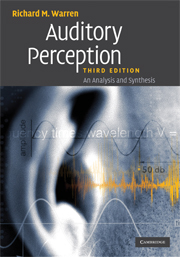Book contents
- Frontmatter
- Contents
- Preface
- 1 Sound and the auditory system
- 2 Spatial localization and binaural hearing
- 3 Perception of acoustic repetition: pitch and infrapitch
- 4 Judging auditory magnitudes: the sone scale of loudness and the mel scale of pitch
- 5 Perception of acoustic sequences
- 6 Perceptual restoration of missing sounds
- 7 Speech
- 8 The relation of hearing to perception in general
- References
- Index
3 - Perception of acoustic repetition: pitch and infrapitch
Published online by Cambridge University Press: 18 May 2010
- Frontmatter
- Contents
- Preface
- 1 Sound and the auditory system
- 2 Spatial localization and binaural hearing
- 3 Perception of acoustic repetition: pitch and infrapitch
- 4 Judging auditory magnitudes: the sone scale of loudness and the mel scale of pitch
- 5 Perception of acoustic sequences
- 6 Perceptual restoration of missing sounds
- 7 Speech
- 8 The relation of hearing to perception in general
- References
- Index
Summary
This chapter reviews a classical problem, perception of tones, and suggests that our understanding of this topic may be enhanced by considering it as part of a larger topic: that of perception of acoustic repetition. As we shall see, periodic sounds repeated at tonal and infratonal frequencies appear to form a single perceptual continuum, with study in one range enhancing understanding in the other.
Terminology
Some terms used in psychoacoustics are ambiguous. The American National Standards Institute (ANSI, 1976/1999) booklet Acoustical Terminology defines some basic technical words as having two meanings, one applying to the stimulus and the other to the sensation produced by the stimulus. The confusion of terms describing stimuli and their sensory correlates is an old (and continuing) potential cause of serious conceptual confusions – a danger that in 1730 led Newton (1952, p. 124) to warn that it is incorrect to use such terms as red light or yellow light, since “ … the Rays to speak properly are not coloured.” However, the ANSI definitions for the word “tone” reflect current usage, and state that the word can refer to: “(a) Sound wave capable of exciting an auditory sensation having pitch. (b) Sound sensation having pitch.” A similar ambiguity involving use of the same term to denote both stimulus and sensation is stated formally in the ANSI definitions for the word “sound.” The use of both of these terms will be restricted here to describe only the stimuli.
- Type
- Chapter
- Information
- Auditory PerceptionAn Analysis and Synthesis, pp. 64 - 106Publisher: Cambridge University PressPrint publication year: 2008



